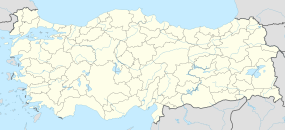Hissarlik
| Turkish: Hisarlık | |

Archeological plan of Hisarlik
|
|
| Alternate name | Troy |
|---|---|
| Coordinates | 39°57′25″N 26°14′20″E / 39.957°N 26.239°E |
Hisarlik (Turkish: Hisarlık, "Place of Fortresses"), often spelled Hissarlik, is the modern name for the generally agreed site of ancient Troy, also known as Ilion, and is located in what is now Turkey (historically Anatolia). The unoccupied archaeological site lies approximately 6.5 km from the Aegean Sea and about the same distance from the Dardanelles.
The archaeological site of Hisarlik is known in archaeological circles as a tell. A tell is an artificial hill, built up over centuries and millennia of occupation from its original site on a bedrock knob. The assumed location of Troy was apparently well known in the ancient world, and was visited by Alexander the Great. In more modern times, a site associated with Ilium (and more readily identifiable as Hisarlik) was being shown to curious visitors as early as the 15th century, when Pedro Tafur was guided from the Genoese port of Fojavecchia (Phocaea):
I travelled by land for two days to that place which they say was Troy, but found no one who could give me any information concerning it, and we came to Ilium, as they call it. This place is situated on the sea opposite the harbour of Tenedos. The whole of this country is strewn with villages, and the Turks regard the ancient buildings as relics and do not destroy anything, but they build their houses adjoining. That which made me understand that this was, indeed, ancient Troy, was the sight of such great ruined buildings, and so many marbles and stones, and that shore, and the harbour of Tenedos over against it, and a great hill which seemed to have been made by the fall of some huge building.
Pedro, like most early visitors, was distracted by the more prominent Hellenistic and Roman remains close to the modern shoreline. An alternative site, Hisarlik tell, a thirty-meter-high mound, was identified as a possible site of ancient Troy by a number of amateur archaeologists in the early to mid 19th century. The most dedicated of these was Frank Calvert, whose early work was overshadowed by the now infamous German amateur archaeologist Heinrich Schliemann in the 1870s.
...
Wikipedia

